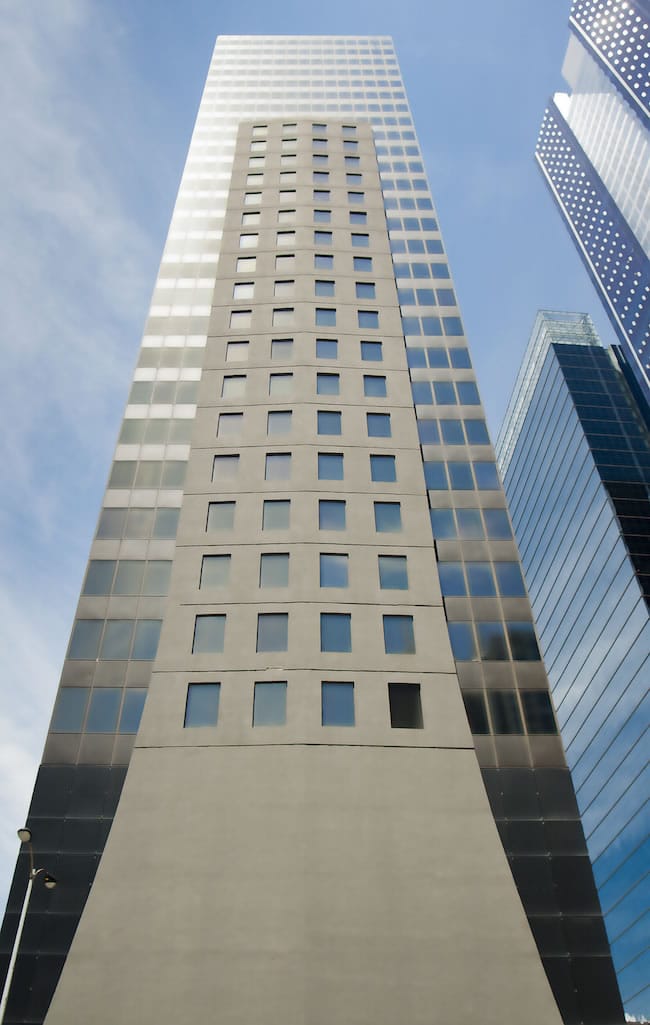When the investment community chooses sustainability as a criteria, the skylines of the world sway in response. Last year, the national real estate investment firm American Realty Advisors made a major retrofit of its 31-story office tower at 150 Wacker Dr. in the financial district of downtown Chicago, focusing on water conservation among other sustainability measures. The results are a 4,000-gallon-per-day reduction in water use, totaling 1 million gallons per year—equivalent to 21% less consumption.
“We took a comprehensive look at operations and maintenance,” says Jay Butterfield, managing director of fund/separate account operations at American, “and found that in addition to saving the water itself, the strategy significantly reduced the energy needed to handle water and sewage.” Simply by replacing 115 restroom sink aerators, four showers, and three women’s toilets with lower flow versions, the energy needed to handle water and sewage for the building was reduced by 90,750 kilowatt hours per year, which equates to a savings of 62.6 metric tons of carbon dioxide annually. “These are substantial numbers that will move the needle in a big way, both for the environment and for the asset’s bottom line,” say Butterfield.

Jay Butterfield, managing director of fund/separate account operations at American Realty Advisors.
Butterfield says that investors can expect an ongoing annual savings of up to three times the amount of the initial one-time cost of installing the water conservation fixtures.
The Wacker-Randolph Building received several other highly targeted alterations, such as reducing air handler run times and installing a reflective roof membrane to reduce heat gain. Butterfield estimates that the least-change-for-greatest-effect approach will result in a five-month payback period on the investment. “The long-term benefits of these specific sustainability features heavily outweighed any initial capital required for implementation.”
The building was already LEED certified, but is expecting recertification with LEED Silver as a result of the renovations.
REAPING MULTIPLE REWARDS
Los Angeles-based American Realty Advisors is an investment manager for institutional investors, a service it has provided for over a quarter century to primary investors and developers in the office, industrial, multi-family, and retail sectors. With over $6 billion in assets under management, it has the weight to make a big impact on energy and resource use at a national scale. The Wacker-Randolph tower was the first of American’s assets to undergo a sustainability evaluation, but the process is now being applied to many others in its portfolio of office buildings, which includes 11.6 million square feet of real estate spread over 77 properties with a total fair market value of over $4 billion.
As an investment firm, the company’s choices are ultimately driven by their clients. Citing EPA statistics that commercial buildings account for 39% of total energy use, 12% of total water consumption, and 38% of total greenhouse/carbon dioxide emissions domestically, Butterfield says that American “recognizes that commercial real estate can have a profound effect on the environment. Whether due to changes in the law, tenant demand, or property valuation, energy conservation and sustainable practices are becoming increasingly important to property owners and investors.” However, he emphasizes that return-driven investors are not necessarily wooed by elaborate sustainability-touting design concepts, but expect a highly practical response to these challenges.
In launching their sustainability initiative, American first focused data collection, benchmarking each property’s energy and water consumption. They looked at things like utility and government rebates that could offset the cost of efficiency upgrades, particularly for their assets in drought-impacted areas where water conservation is being heavily incentivized. With this information in hand, they were able to identify the properties that could best benefit from an energy audit. A case study of each audited building is being developed in order to create a checklist of best practices that will be implemented across the portfolio.
The company’s take-aways thus far? “Two big lessons we learned were that sustainability efforts do not need to cost a lot to improve the building’s efficiency and bottom line and, second, that it’s important to involve tenants with sustainability efforts from the beginning,” says Butterfield. At the Wacker-Randolph building, for example, they’ve implemented a green cleaning program that minimizes unhealthy cleaning compounds and strongly encourages recycling by the tenants. “We believe by ensuring that our tenants have healthy buildings that it will help our tenant retention,” adds Butterfield, emphasizing another link between their sustainability program and the rewards they are already seeing for investors.
American’s research into the subject consistently shows that reducing a property’s energy usage by 30% results in up to a 5% increase in both net operating income and asset value. There is also a clear correlation between LEED certification and the attractiveness of a building to high quality tenants. “Sustainability is not only the right thing to do but also the smart thing to do,” says Butterfield. “It gives portfolios a clear competitive advantage.”

